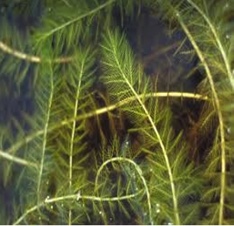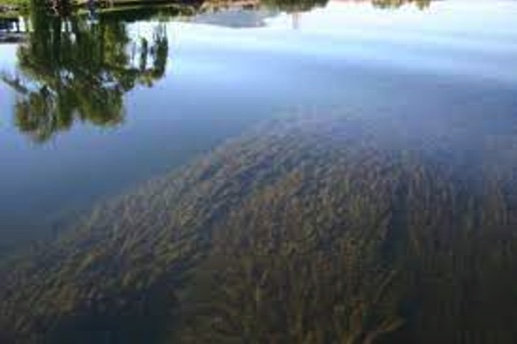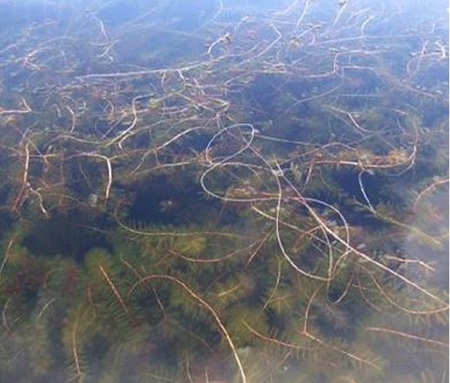By Chris Redston, Bay of Islands Community Association
Have you noticed more weeds in the water the last couple of years? It could be an invasive aquatic plant called Eurasian Watermilfoil.
Eurasian Watermilfoil (EWM) has feather-like green leaves with 12-14 or more thread-like segments. It prefers to grow in slow-moving water, 1m to 3m deep (3 to 10 feet), with sand or silt bottom.

Like many invasive species in the Great Lakes, EWM was likely introduced by ballast water from the shipping industry in the 1960’s and continues to spread into new waterways by boaters that carry plant pieces on their boats and trailers.
EWM also spreads on its own through a process called auto-fragmentation. In late summer, pieces of the weed break off and float away – all on their own. Fragments settle and start new colonies. EWM is now established in all the Great Lakes and many surrounding waterways throughout Canada and the United States – including the Bay of Islands.
Eurasian Watermilfoil in the Bay of Islands
EWM has been quietly growing throughout the Bay of Islands for many years. EWM spreads quickly and crowds out native weeds, eventually growing into thick beds that block sunlight and negatively affect fish habitat. It also interferes with swimming and boating and all the other activities that we enjoy in and around the water.
There are now some large beds in calm waters and narrow inlets throughout our waterways. Once you learn how to identify EWM you’ll start to spot it in many locations. You may even have EWM around your dock and shallow waters around your island.
What can we do about it?
Unfortunately, once EWM is established in a lake, it has proven almost impossible to eradicate. However, there are things we can do to slow the spread.
Living with Eurasian Watermilfoil
If you have EWM beds near your dock and they are interfering with your recreational use and enjoyment of the water, there are options available to manage the weeds.
The Ontario Invasive Plant Council has published Best Management Practices for managing EWM. Control measures include hand removal, raking, mechanical and suction harvesting, and placing benthic barriers. The North American Weevil has been used quite effectively as a biological control measure in small lakes, but biological methods are not a realistic option in the Great Lakes. Please consult the Best Management Practices above for information on when is the best time to remove EWM so as not to disturb and harm the local fish.
Interested in learning more?
Check out the following resources:
https://www.ontarioinvasiveplants.ca/
https://www.ontario.ca/page/eurasian-water-milfoil
https://www.invasivespeciescentre.ca/
https://www.invadingspecies.com/invaders/aquatic-plants/eurasian-water-milfoil-2/
https://www.natureconservancy.ca/en/what-we-do/resource-centre/invasive-species/eurasian-milfoil.html
https://www.eddmaps.org/distribution/viewmap.cfm?sub=3055
https://www.invasivespeciesinfo.gov/aquatic/plants/eurasian-watermilfoil

